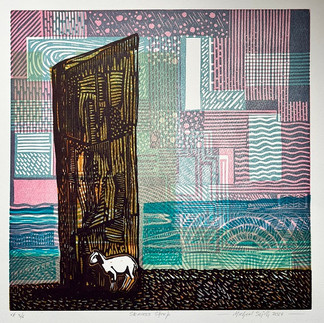The Stones of Stenness, Orkney - a special linocut print
- Michael Smith
- Jul 1, 2024
- 3 min read

On a recent trip to Orkney I was struck not only by the landscape but also by the sense of endless movement - skies, weather, seas and, of course, people. This is a landscape of mood, movement and magnificence.
For such a relatively small archipelago, Orkney is rich in history and continues to be distinct. Its connections to Scotland and Norway and its former status as a naval base for the British Grand Fleet give it a fundamental connection to other places, other people, other cultures.
The result of this exposure is an extensive archaeological legacy including sites and finds from the mesolothic and neolithic, and the later periods of the Picts, Norse and Scots.
Even the Italians left their mark in the form a distinctive church built by WW2 PoWs which, when I was there, was the being visited by three coach parties of Italian tourists from a large cruise ship docked in Kirkwall.
The Stones of Stenness and the Ring of Brodgar

Perhaps the most evocative and dramatic sites in the archipelago are the Stones of Stenness and the Ring of Brodgar. In recent times, extensive excavations have taken place between the two sites revealing an astonishing wealth of evidence as layer upon layer of different building phases have been uncovered in a manner not dissimilar to Troy.

For me, the Stones of Stenness exude an exceptional presence. Their height, regularity of shape, slenderness and singularity are immediately inspirational, especially with sheep cowering in their shadow, sheltering from biting winds and piercing rain.
I don't think it is possible for anyone to drive by these stones without having to stop and experience their power, set between the lochs of Stenness and Harrary with views towards the looming presence of Hoy in the distance.

Making a linocut print of the Stones of Stenness

In making a linocut of this fabulous site, I was inspired by the art form of the stones themselves.
Although they are devoid of detailed art in themselves, the stones are nonetheless artistic; they are placed to have presence. Their shape has meaning.
They are the only witness we have to the people who put them there - their lives, their view of the world; their experience of existence.
Hence, in creating my linocut, I wanted to suggest a former vitality, creating abstract patterns running through the landscape indicative of weather, walking, farming, sailing and the mystery of centuries of silence.

I decided to produce a print involving over-layering transparent blocks in different colours, reflective also of early fabrics and textiles.
In the end, I ran five blocks through six different colours on the press. The result intentionally resembles weaving motifs while also suggesting movement and vitality.
The inclusion of the sheep in the composition is intentional - a reflection of the harsh conditions but also of the theme of fabric and textiles I see running through the piece.
The entire process took hours of cutting as well as days of patient printmaking work on the Albion press.
Only six of the twelve prints which emerged were successful. Each is different - producing what is called a "variable edition" (VE) of six.
The final edition of the Stones of Stenness linocut print
The nature of linocut work, especially one of such complexity as this, is that each print will look different, evoking different feelings in the mind of the owner/collector.
Each print carries the number in the edition (e.g. VE 4/6), the title ("Stenness Sheep") and is signed by me. These are all hand-produced original prints, with each layer individually inked and pressed by hand on a Victorian Albion press - no modern process has been involved in their making.
I am delighted with the variety of mood which emerges from the edition. I currently have four still for sale through my online shop. If you would like one, please order yours as soon as possible.
About the author, Michael Smith

Michael Smith is a translator and illustrator of medieval literature; he is also an accomplished printmaker, whose work is in private collections worldwide.
His books, including a translation of Sir Gawain and the Green Knight and the Alliterative Morte Arthure, are available through all the usual outlets. His forthcoming translation of The Romance of William and the Werewolf is published in October 2024. All Michael's books feature his linocut prints as their illustrations.
For more details of Michael's books and how to purchase signed copies, click here.













Comments